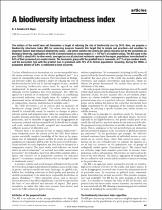JavaScript is disabled for your browser. Some features of this site may not work without it.
- ResearchSpace
- →
- Research Publications/Outputs
- →
- Journal Articles
- →
- View Item
| dc.contributor.author |
Scholes, RJ

|
en_US |
| dc.contributor.author |
Biggs, R

|
en_US |
| dc.date.accessioned | 2007-03-26T07:06:26Z | en_US |
| dc.date.accessioned | 2007-06-07T10:08:26Z | |
| dc.date.available | 2007-03-26T07:06:26Z | en_US |
| dc.date.available | 2007-06-07T10:08:26Z | |
| dc.date.issued | 2005-03-03 | en_US |
| dc.identifier.citation | Scholes, RJ and Biggs, R. 2005. Biodiversity intactness index. Nature, vol. 434(7029), pp 45-49 | en_US |
| dc.identifier.issn | 0028-0836 | en_US |
| dc.identifier.uri | http://hdl.handle.net/10204/2026 | en_US |
| dc.identifier.uri | http://hdl.handle.net/10204/2026 | |
| dc.description.abstract | The nations of the world have set themselves a target of reducing the rate of biodiversity loss by 2010. Here, we propose a biodiversity intactness index (BII) for assessing progress towards this target that is simple and practical - but sensitive to important factors that influence biodiversity status - and which satisfies the criteria for policy relevance set by the Convention on Biological Diversity. Application of the BII is demonstrated on a large region (4 3 10 6 km 2) of southern Africa. The BII score in the year 2000 is about 84%: in other words, averaged across all plant and vertebrate species in the region, populations have declined to 84% of their presumed pre-modern levels. The taxonomic group with the greatest loss is mammals, at 71% of pre-modern levels, and the ecosystem type with the greatest loss is grassland, with 74% of its former populations remaining. During the 1990s, a population decline of 0.8% is estimated to have occurred. | en_US |
| dc.format.extent | 187473 bytes | en_US |
| dc.format.mimetype | application/pdf | en_US |
| dc.language.iso | en | en_US |
| dc.publisher | Nature Publishing Group | en_US |
| dc.rights | Copyright: 2005 Nature Publishing Group | en_US |
| dc.subject | Biodiversity | en_US |
| dc.subject | Biodiversity intactness index | en_US |
| dc.subject | Biological diversity | en_US |
| dc.subject | Ecosystems | en_US |
| dc.subject | Taxonomic group | en_US |
| dc.title | Biodiversity intactness index | en_US |
| dc.type | Article | en_US |
| dc.identifier.apacitation | Scholes, R., & Biggs, R. (2005). Biodiversity intactness index. http://hdl.handle.net/10204/2026 | en_ZA |
| dc.identifier.chicagocitation | Scholes, RJ, and R Biggs "Biodiversity intactness index." (2005) http://hdl.handle.net/10204/2026 | en_ZA |
| dc.identifier.vancouvercitation | Scholes R, Biggs R. Biodiversity intactness index. 2005; http://hdl.handle.net/10204/2026. | en_ZA |
| dc.identifier.ris | TY - Article AU - Scholes, RJ AU - Biggs, R AB - The nations of the world have set themselves a target of reducing the rate of biodiversity loss by 2010. Here, we propose a biodiversity intactness index (BII) for assessing progress towards this target that is simple and practical - but sensitive to important factors that influence biodiversity status - and which satisfies the criteria for policy relevance set by the Convention on Biological Diversity. Application of the BII is demonstrated on a large region (4 3 10 6 km 2) of southern Africa. The BII score in the year 2000 is about 84%: in other words, averaged across all plant and vertebrate species in the region, populations have declined to 84% of their presumed pre-modern levels. The taxonomic group with the greatest loss is mammals, at 71% of pre-modern levels, and the ecosystem type with the greatest loss is grassland, with 74% of its former populations remaining. During the 1990s, a population decline of 0.8% is estimated to have occurred. DA - 2005-03-03 DB - ResearchSpace DP - CSIR KW - Biodiversity KW - Biodiversity intactness index KW - Biological diversity KW - Ecosystems KW - Taxonomic group LK - https://researchspace.csir.co.za PY - 2005 SM - 0028-0836 T1 - Biodiversity intactness index TI - Biodiversity intactness index UR - http://hdl.handle.net/10204/2026 ER - | en_ZA |






